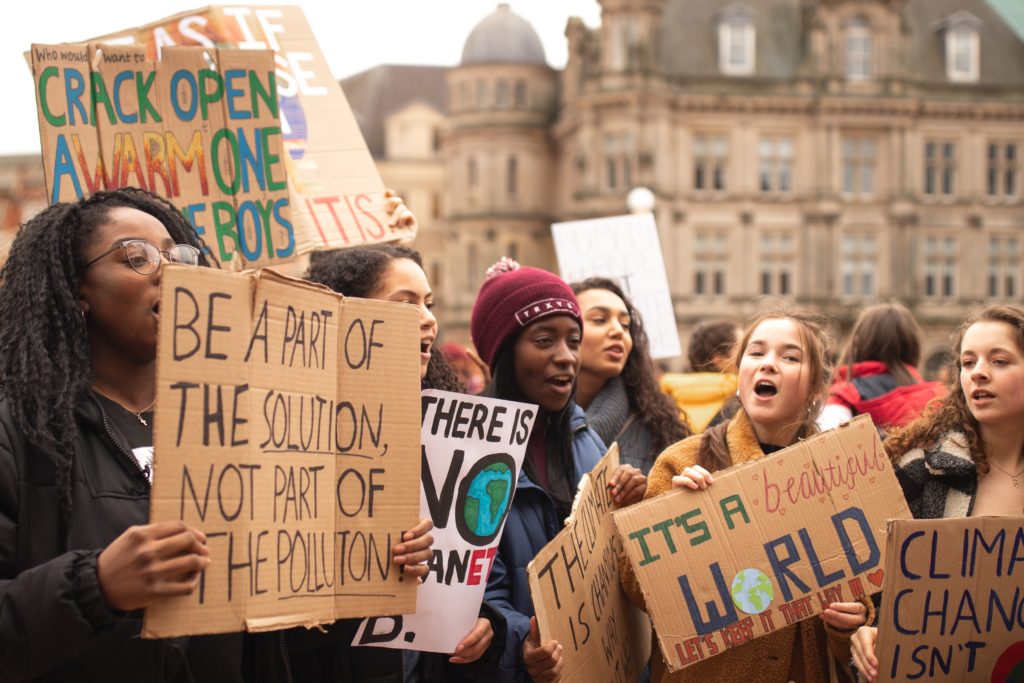
My generation is angry. And anxious. We’re in our 20s and 30s now, looking ahead to decades of living with the ever more destructive effects of climate change. We are scared. But we are also taking action.
Choosing to Not Look Away
According to a recent survey conducted by Pew Research, nearly 70% of Gen Z (born after 1996) and nearly 60% of Millennial (born 1981-96) social media users say it makes them feel anxious about the future when they see content about climate change. Fewer than half of older social media users say they feel this way. But young people are not paralyzed by their fear. Instead of disengaging, more than half of younger respondents say they actually feel motivated to learn more about climate change issues. Pew’s findings also show that Gen Zers and Millennials are talking more about the need for action; they are seeing more climate change content online; and they are doing more to get involved through activities such as volunteering and attending rallies and protests.
Taking Action Locally
What difference can we as individuals make to a planetary-scale threat like climate change? While only world-wide emissions reductions by the most polluting industries have the power to significantly slow climate change, we still have a choice to make: use power we do have as consumers and voters to influence whatever climate change mitigation is still possible, use our vision and compassion to create more sustainable ways of life on the local level, or choose to close our eyes and hearts and continue with business as usual?
I will say more in next week’s blog post about the ethical motivation to move from a culture of consumption and extraction to a lifestyle rooted in care and preservation of life. For now, I want to focus on the fact that, even though we cannot reverse climate change, we can mitigate it and adapt to it. And that is something each of us can advocate for and change on the local level. As laid out in this article by NASA, “while climate change is a global issue, it is felt on a local scale(…)In the absence of national or international climate policy direction, cities and local communities around the world have been focusing on solving their own climate problems.”
A Precedent for Hope: The Earth Day Movement
And there is a precedent in recent history of a popular movement that grew to effect massive policy change in the space of just two years: Earth Day . The very first Earth Day event, in 1970, inspired 20 million Americans — at the time, 10% of the total population of the United States — to take to the streets to demonstrate against the impacts of 150 years of industrial development which had created serious human health impacts. By the end of 1970, the first Earth Day led to the creation of the United States Environmental Protection Agency and the passage of other first of their kind environmental laws in the following three years, including the National Environmental Education Act, the Occupational Safety and Health Act, the Clean Air and Water Acts, and the Endangered Species Act.
How did a team of 85 campaign staff, in a space of just 14 months, manage to turn one man’s idea into a movement of 20 million Americans? Two strategies led to this success:
- A unified vision – emphasizing the common good, how all environmental concerns and solutions are interconnected in our one planetary ecosystem;
- Decentralization – focusing on personal relationships on the local level, empowering a wide range of organizations to mobilize their respective communities.
Acting Together for the Common Good
Groups that had been fighting individually against oil spills, polluting factories, toxic dumps, pesticides, freeways, the loss of wilderness and the extinction of wildlife united on Earth Day around shared common values. A diverse yet coordinated national movement brought together local advocacy groups, faith communities, and colleges. Their message: Harm to the environment, our common home, anywhere is harm to all of us everywhere.
If these principles remind you of our approach at Paths to Understanding, you’re exactly right.
- We foster relationships between diverse communities, based on shared values
- We stand together against all forms of hate and oppression, because a threat to one group’s rights is a threat to peace and democracy for all of us
- We equip individuals and local groups with information, tools, and networks they can use to act for the common good right where they are
Today, Earth Day is recognized as the largest secular observance in the world. Every year on this day, more than a billion people in 193 countries protest, raise awareness, and start projects to change human behavior and global, national and local policies. Join us in following their example and doing what we can, right where we are.
Photo by Callum Shaw on Unsplash
[author] [author_image timthumb=’off’]https://pathstounderstanding.org/wp-content/uploads/2021/07/IMG_20190727_180205-Copy-1.jpg[/author_image] [author_info]by Carla Penderock, Director of Contributor Relations at Paths to Understanding[/author_info] [/author]
